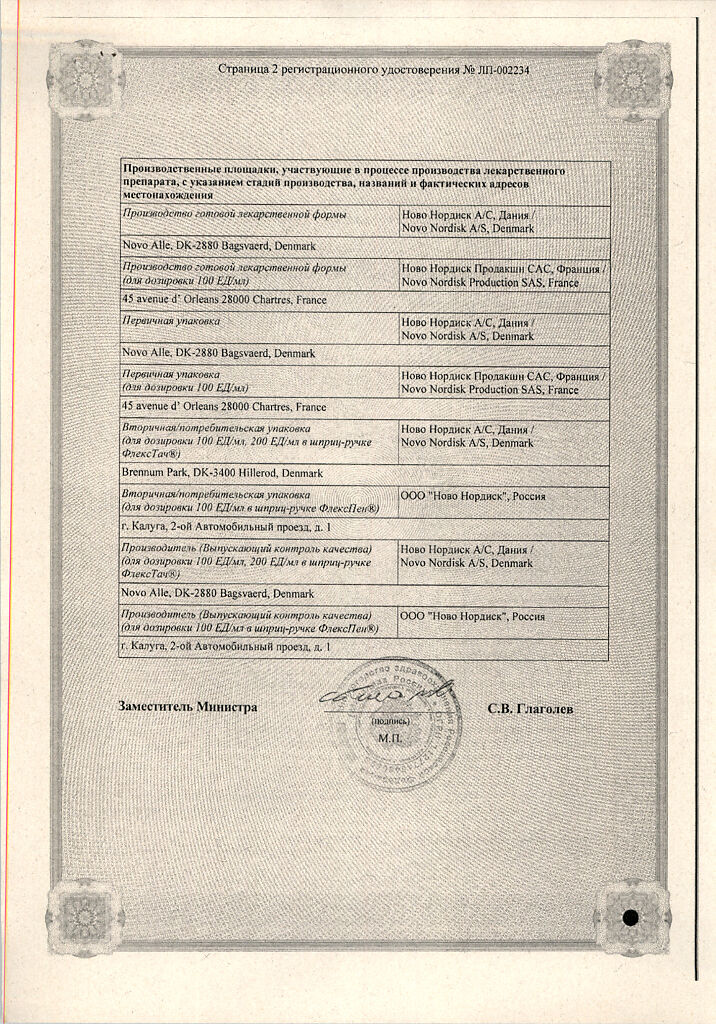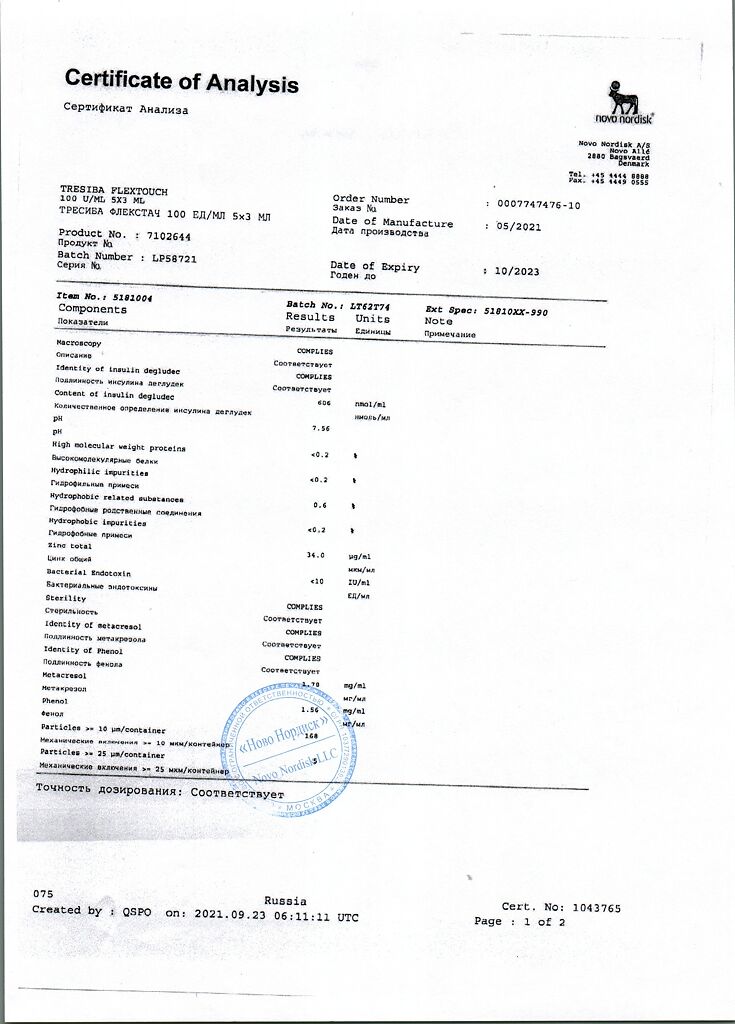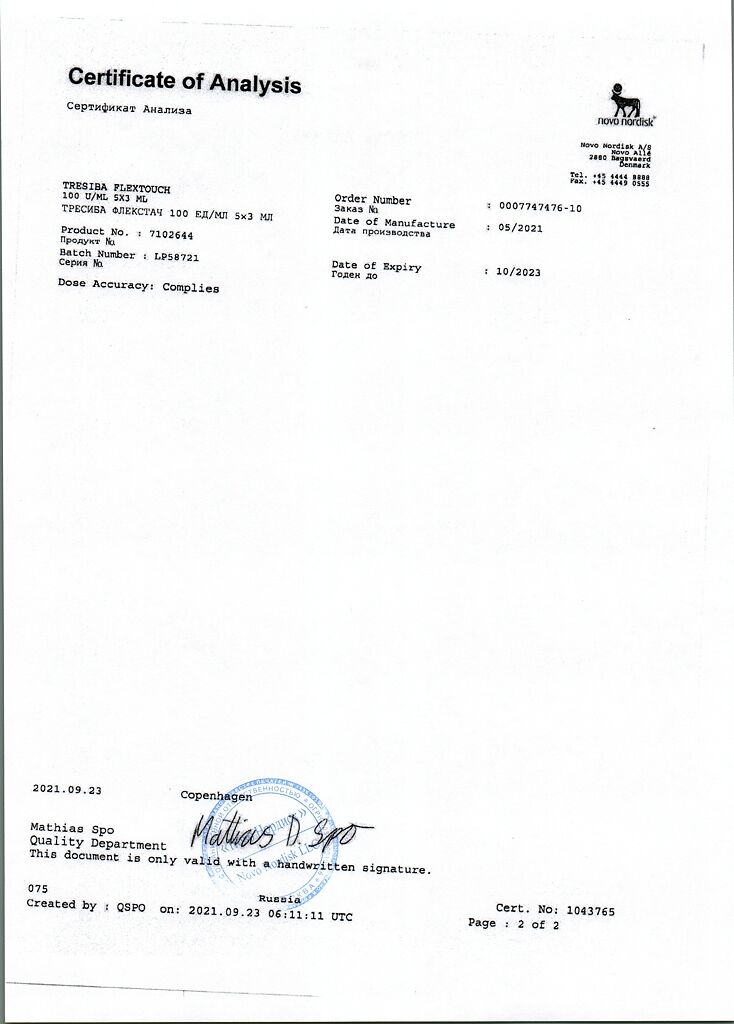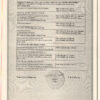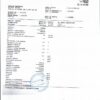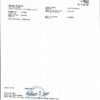No products in the cart.
Tresiba FlexTouch, 100 units/ml 3 ml cartridges in syringe pens 5 pcs
€120.97 €100.81
Description
The drug Tresiba FlexTouch is an ultra-long-acting human insulin analog produced by recombinant DNA biotechnology using a Saccharomyces cerevisiae strain.
Mechanism of action
Insulin degludec binds specifically to the human endogenous insulin receptor and, interacting with it, realizes its pharmacological effect similar to that of human insulin.
The hypoglycemic effect of insulin degludek is due to increased glucose utilization by tissues after insulin binds to receptors on muscle and fat cells and simultaneously decreased rate of glucose production by the liver.
Pharmacodynamics
The drug Tresiba FlexTouch is a basal counterpart of ultra-long-acting human insulin; Upon injection, it forms soluble multi-hexamers in a subcutaneous depot from which insulin degludec is continuously and prolongedly absorbed into the bloodstream, providing an ultra-long flat action profile and a stable hypoglycemic effect of the drug. Tresiba FlexTouch, unlike insulin glargine, demonstrated a uniform Vd between the first and second 12-hour periods (AUCGIR.0-12h,SS/AUCGIR,total,SS = 0.5) during the 24-hour period monitoring the hypoglycemic action of the drug in patients dosed with insulin degludec once daily.
The duration of action of Tresiba FlexTouch is greater than 42 h within the therapeutic dose range. Css of the drug in blood plasma is reached 2-3 days after administration of the drug.
. Insulin degludec in the Css state demonstrates significantly less (4-fold) variability in daily hypoglycemic action profiles compared to insulin glargine as assessed by value of coefficient of variability (CV) for study of hypoglycemic action of drug during one dosing interval (AUCGIR,t,SS) and within time period from 2 to 24 h (AUCGIR2-24h,SS).
Table 1. Variability of daily hypoglycemic action profiles of Tresiba FlexTouch and insulin glargine at equilibrium concentration state in patients with type 1 diabetes mellitus
Insulin degludec
(n=26)
(CV%)Insulin
br> glargin
(n=27) (CV%)Variability of daily hypoglycemic action profiles over a single dosing interval (AUCGIR,t,SS)2082Variability of daily hypoglycemic action profiles over a time interval of 2 to 24 h (AUCGIR2-24h,SS)2292
VC Intraindividual variability coefficient in %.
SS: equilibrium drug concentration.
AUCGIR2-24h: metabolic effect in the last 22 h of the dosing interval (i.e., no effect of IV injected insulin during the introductory clamp study period).
A linear relationship has been proven between the increasing dose of Tresiba FlexTouch and its overall hypoglycemic effect.
The two dosage forms of Tresiba FlexTouch, 100 units/ml and 200 units/ml, demonstrated a comparable overall hypoglycemic effect when each of the two dosages of the drug was administered at the same total dose.
There have been no clinically significant differences in pharmacodynamics of Tresiba FlexTouch between elderly patients and young adult patients.
Clinical efficacy and safety
. There were 11 international randomized, open-label Treat-to-Target (a “treat-to-target” strategy), 26- and 52-week parallel-group clinical trials that included a total of 4,275 patients (1,102 patients with type 1 diabetes and 3,173 patients with type 2 diabetes) treated with Tresiba FlexTouch.
The efficacy of Tresiba FlexTouch was studied in patients with type 1 diabetes mellitus who had not previously received insulin and with type 2 diabetes mellitus who received insulin therapy, in fixed or flexible dosing regimens of Tresiba FlexTouch. No superiority of comparison drugs (insulin detemir and insulin glargine) over Tresiba FlexTouch in terms of HbA1c reduction from inclusion to the end of the study was proved. The exception was sitagliptin, compared to which Tresiba FlexTouch showed statistically significant superiority with respect to HbA1c reduction.
. Results of a clinical trial (a “treat-to-target” strategy) on initiation of insulin therapy in patients with type 2 diabetes demonstrated a 36% reduction in the incidence of episodes of confirmed nocturnal hypoglycemia (defined as episodes of hypoglycemia occurring between 0 a.m. and 6 a.m. as confirmed by plasma glucose measurements). The results of a prospective meta-analysis of data from seven “treat-to-target” clinical trials with patients with type 1 and type 2 diabetes mellitus demonstrated benefits of Tresiba FlexTouch therapy with respect to the lower incidence of confirmed hypoglycemia episodes and confirmed nocturnal hypoglycemia episodes compared to insulin glargine therapy. Reduced incidence of hypoglycemic episodes with treatment with Tresiba FlexTouch was achieved with lower mean fasting plasma glucose than with treatment with insulin glargine.
Table 2. Results of a meta-analysis of data on episodes of hypoglycemia
Calculated risk ratio (insulin degludec/insulin glargine)Episodes
hypoglycemiaTotal
* Statistically significant.
a Confirmed hypoglycemia is an episode of hypoglycemia confirmed by measurement of plasma glucose concentration
b Episodes of hypoglycemia after week 16 of therapy.
There was no clinically significant formation of insulin antibodies after treatment with Tresiba FlexTouch over an extended period of time.
Pharmacokinetics
Absorption
The extra-long action of insulin degludec is due to the specially designed structure of its molecule. After injection, soluble, stable multi-hexamers form and create an insulin depot in the subcutaneous fatty tissue. The multi-hexamers gradually dissociate, releasing insulin degludec monomers, resulting in a slow and prolonged release of the drug into the blood.
The plasma Css of Tresiba is reached 2-3 days after drug administration.
The 24-hour action of insulin degludec when administered once daily is evenly distributed between the first and second 12-hour intervals (AUCGIR.0-12h,SS/AUCGIR,t,SS= 0.5).
Distribution
The binding of insulin degludec to plasma proteins (albumin) is >99%.
Metabolism
The breakdown of degludec insulin is similar to that of human insulin; all metabolites produced are inactive.
Elimation
The T1/2 after b/c injection of Tresiba FlexTouch is determined by its rate of absorption from the subcutaneous tissue, is approximately 25 h and is independent of dose.
Linearity
When administered b/c, total plasma concentrations were proportional to the administered dose over the therapeutic dose range. In a direct comparison of the two dosage forms of Tresiba FlexTouch, 100 units/ml and 200 units/ml, data were obtained to demonstrate their bioequivalence (based on the AUCIDeg.t.SS and Cmax,IDeg.SS data obtained).
Pharmacokinetics in Special Patient Groups
No differences were found in the pharmacokinetic properties of Tresiba FlexTouch based on patient gender.
There were no clinically significant differences in the pharmacokinetics of insulin degludec between elderly and young patients, between patients of different ethnic groups, between patients with renal and hepatic dysfunction and healthy patients.
The pharmacokinetic properties of insulin degludec in children (6-11 years) and adolescents (12-18 years) with type 1 diabetes are comparable to those of adult patients. In a single-dose study in patients with type 1 diabetes mellitus, it was demonstrated that the cumulative effect of the drug dose was greater in children and adolescents compared to that in adult patients.
Preclinical data based on studies of pharmacological safety, repeated-dose toxicity, carcinogenic potential, and reproductive toxicity have not demonstrated any risk of insulin degludec in humans.
The ratio of metabolic to mitogenic activity of insulin degludec is similar to that of human insulin.
Indications
Indications
Diabetes mellitus in adults.
Active ingredient
Active ingredient
Composition
Composition
1 ml of the solution contains:
active ingredient:
insulin degludec 100 units,
excipients:
Glycerol,
Phenol,
Methacresol,
Zinc (in the form of zinc acetate),
Hydrochloric acid/sodium hydroxide (for pH correction),
water for injection.
Interaction
Interaction
There are a number of medications that affect the need for insulin.
The need for insulin can decrease: oral hypoglycemic drugs, glucagon-like peptide-1 (GFP-1) receptor agonists, MAOI inhibitors, nonselective beta-adrenoblockers, ACE inhibitors, salicylates, anabolic steroids and sulfonamides.
Insulin requirements may be increased by:oral hormonal contraceptives, thiazide diuretics, GCS, thyroid hormones, sympathomimetics, somatropin and danazol.
Beta-adrenoblockers may mask symptoms of hypoglycemia.
Octreotide/lanreotide can both increase and decrease the body’s need for insulin.
Ethanol (alcohol) can both increase and decrease the hypoglycemic effect of insulin.
Incompatibility
Some medicines can cause Tresiba FlexTouch to break down when added to it.
Tresiba FlexTouch should not be added to infusion solutions.
Tresiba FlexTouch should not be mixed with other medicinal products.
Contraindications
Contraindications
Side effects
Side effects
The most common side effect reported during treatment with insulin degludec is hypoglycemia.
An organ systemFrequentImmune system disorders rarely – hypersensitivity reactions rarely – urticaria Metabolic and nutrition disorders very common – hypoglycemia Skin and subcutaneous tissue disorders infrequent – lipodystrophyGeneral disorders and disorders at the injection site infrequent – reactions at the injection site infrequent – peripheral edema/p>
Description of individual adverse reactions
Immune system disorders
The use of insulin products may cause allergic reactions. Immediate type allergic reactions to the insulin drug itself or to its excipients may be potentially life-threatening.
Hypersensitivity reactions (including swelling of the tongue or lips, diarrhea, nausea, fatigue and skin itching) and urticaria have rarely been reported with Tresiba FlexTouch.
Hypoglycemia
Hypoglycemia can occur if the insulin dose is too high relative to the patient’s insulin needs. Severe hypoglycemia can lead to loss of consciousness and/or seizures, temporary or permanent impairment of brain function up to and including death. Symptoms of hypoglycemia usually develop suddenly. They include “cold sweats,” pale skin, increased fatigue, nervousness or tremors, anxiety, unusual fatigue or weakness, disorientation, decreased concentration, drowsiness, marked hunger, visual disturbances, headache, nausea, palpitations.
Lipodystrophy
Lipodystrophy (including lipohypertrophy, lipoatrophy) may develop at the injection site. Adherence to injection site changes within the same anatomical area helps reduce the risk of this adverse reaction.
Reactions at the site of injection
Patients who have received Tresiba FlexTouch have experienced injection site reactions (hematoma, pain, local hemorrhage, erythema, connective tissue nodules, swelling, skin discoloration, itching, irritation, and thickening at the injection site). Most injection site reactions are mild and transient and usually disappear with continued treatment.
Children and adolescents
The pharmacokinetic properties of Tresiba FlexTouch have been studied in children and adolescents under 18 years of age. Efficacy and safety studies of insulin degludec in children and adolescents have not been conducted.
Special patient groups
No differences in frequency, type, or severity of adverse reactions were found in clinical studies between elderly patients and patients with impaired renal or hepatic function and the general patient population.
Overdose
Overdose
There is no specific dose required for insulin overdose, but hypoglycemia may develop gradually if a dose of the drug that is too high compared to the patient’s need has been administered.
Treatment: Mild hypoglycemia can be managed by the patient by ingesting glucose or sugary foods. Therefore, it is recommended that diabetic patients carry sugary foods with them at all times.
In case of severe hypoglycemia when the patient is unconscious, he should be given glucagon (0.5 to 1 mg) in the car or by injection (can be administered by a trained person) or intravenous dextrose (glucose) solution (can only be administered by a healthcare professional). Dextrose should also be administered intravenously if the patient does not regain consciousness 10-15 minutes after glucagon administration. After recovery of consciousness, the patient is advised to take a meal rich in carbohydrates to prevent a relapse.
Pregnancy use
Pregnancy use
The use of Tresiba FlexTouch in pregnancy is contraindicated because there is no clinical experience with its use in pregnant women.
The studies of reproductive function in animals showed no differences between insulin degludec and human insulin in terms of embryotoxicity and teratogenicity.
The use of Tresiba FlexTouch during breastfeeding is contraindicated because there is no clinical experience with its use in breastfeeding women.
Studies in animals have shown that in rats insulin degludec is excreted with breast milk; the concentration of the drug in breast milk is lower than in blood plasma. It is not known whether insulin degludec is excreted with the breast milk of women.
In animal studies, no adverse effects of insulin degludec on fertility have been found.
Additional information
| Shelf life | 30 months |
|---|---|
| Conditions of storage | In a dry dark place out of the reach of children at a temperature of 2 to 8 ° C. |
| Manufacturer | Novo Nordisk A/S, Denmark |
| Medication form | solution |
| Brand | Novo Nordisk A/S |
Related products
Buy Tresiba FlexTouch, 100 units/ml 3 ml cartridges in syringe pens 5 pcs with delivery to USA, UK, Europe and over 120 other countries.


